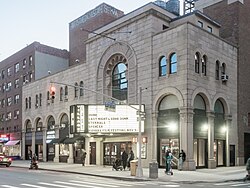
Astor Place is a one-block street in NoHo/East Village, in the lower part of the New York City borough of Manhattan. It runs from Broadway in the west to Lafayette Street. The street encompasses two plazas at the intersection with Cooper Square, Lafayette Street, Fourth Avenue, and Eighth Street – Alamo Plaza and Astor Place Station Plaza. "Astor Place" is also sometimes used for the neighborhood around the street. It was named for John Jacob Astor, soon after his death in 1848. A $21 million reconstruction to implement a redesign of Astor Place began in 2013 and was completed in 2016.
Strand Theatre or Strand Theater may refer to:
Landmark Theatres is the largest specialized movie theatre chain in the United States dedicated to exhibiting and marketing independent and foreign films.

IFC Center is an art house movie theater in Greenwich Village, Manhattan, New York City. Located at 323 Sixth Avenue at West 3rd Street, it was formerly the Waverly Theater, an art house movie theater. IFC Center is owned by AMC Networks, the entertainment company that owns the cable channels AMC, BBC America, IFC, We TV and Sundance TV and the offshoot film company IFC Films.
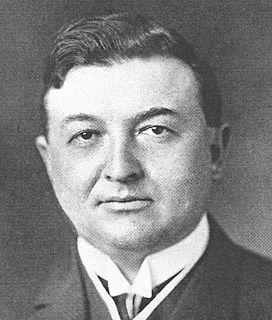
John Adolph Emil Eberson was a Ukrainian American architect best known for the development and promotion of movie palace designs in the atmospheric theatre style. He designed over 500 theatres in his lifetime, earning the nickname "Opera House John". His most notable surviving theatres in the United States include the Tampa Theatre (1926), Palace Theatre (1928), Majestic Theatre (1929) and Paramount Theatre (1929). Remaining international examples in the atmospheric style include both the Capitol Theatre (1928) and State Theatre (1929) in Sydney, Australia, The Forum and Le Grand Rex.

New York City's Theater District is an area and neighborhood in Midtown Manhattan where most Broadway theaters are located, as well as many other theaters, movie theaters, restaurants, hotels, and other places of entertainment. It is bounded by West 40th Street on the south, West 54th Street on the north, Sixth Avenue on the east and Eighth Avenue on the west, and includes Times Square. The Great White Way is the name given to the section of Broadway which runs through the Theater District.
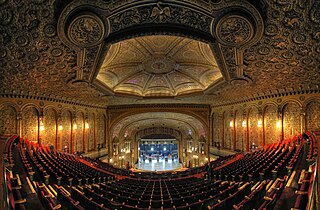
The United Palace is a theater at 4140 Broadway in the Washington Heights neighborhood of Manhattan in New York City. The theater, occupying a full city block bounded by Broadway, Wadsworth Avenue, and West 175th and 176th Streets, functions both as a spiritual center and as a nonprofit cultural and performing arts center. Architect Thomas W. Lamb designed the theater as a movie palace, which opened in 1930 as one of five Loew's Wonder Theatres in the New York City area. The theater's lavishly eclectic interior decor was supervised by Harold Rambusch, who also designed the interior of the Roxy Theatre and the Waldorf-Astoria Hotel.

Maurice Schwartz, born Avram Moishe Schwartz, born in the Volhynia province of Ukraine, was a stage and film actor active in the United States. He founded the Yiddish Art Theatre and its associated school in 1918 in New York City and was its theatrical producer and director. He also worked in Hollywood, mostly as an actor in silent films but also as a film director, producer, and screenwriter.

The Gramercy Theatre is a music venue in New York City. It is located in the Gramercy neighborhood of Manhattan, on 127 East 23rd Street. Built in 1937 as the Gramercy Park Theatre, it is owned and operated by Live Nation as one of their two concert halls in New York City, the other being the nearby Irving Plaza.

The Orpheum Theatre, formerly Player's Theatre, is a 299-seat off-Broadway theatre on Second Avenue near the corner of St. Marks Place in the East Village neighborhood of lower Manhattan, New York City. It has been the home of the New York production of Stomp since it opened in 1994, with over 10,000 performances of the show having taken place there.

The Quad Cinema is New York City's first small four-screen multiplex theater. Located at 34 West 13th Street in Greenwich Village, it was opened by entrepreneur Maurice Kanbar, along with his younger brother Elliott S. Kanbar in October 1972. It has been described as "one of the oldest independent cinemas in the city" and "a vibrant center for art house films."

New York City Center is a 2,257-seat Moorish Revival theater at 131 West 55th Street between Sixth and Seventh Avenues in Midtown Manhattan, New York City, one block south of Carnegie Hall. City Center is a performing home for several major dance companies as well as the Encores! musical theater series and the Fall for Dance Festival. The facility houses the 2,257 seat main stage, two smaller theaters, four studios and a 12-story office tower.

The Irving Place Theatre was located at the southwest corner of Irving Place and East 15th Street in the Union Square neighborhood of Manhattan, New York City. Built in 1888, it served as a German language theatre, a Yiddish theatre, a burlesque house, a union meeting hall, a legitimate theatre and a movie theatre. It was demolished in 1984.
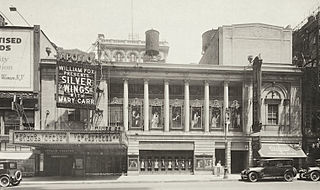
The Apollo Theatre was a Broadway theatre whose entrance was located at 223 West 42nd Street in Manhattan, New York City, while the theatre proper was on 43rd Street. It was demolished in 1996 and provided part of the site for the new Ford Center, now known as the Lyric Theatre.

The Yiddish Art Theatre was a New York Yiddish theatre company of the 20th century.
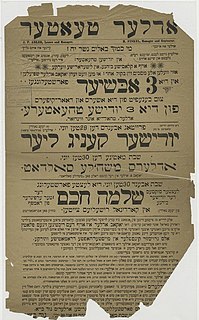
The Yiddish Theatre District, also called the Jewish Rialto and the Yiddish Realto, was the center of New York City's Yiddish theatre scene in the early 20th century. It was located primarily on Second Avenue, though it extended to Avenue B, between Houston Street and East 14th Street in the East Village in Manhattan. The District hosted performances in Yiddish of Jewish, Shakespearean, classic, and original plays, comedies, operettas, and dramas, as well as vaudeville, burlesque, and musical shows.
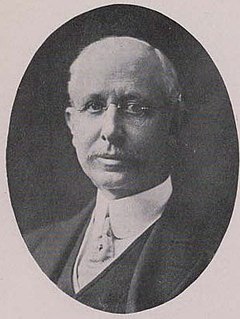
William H. McElfatrick was an American architect who specialized in theaters.

The Phoenix Theatre was a pioneering off-Broadway theatre in New York City, extant from 1953 to 1982.
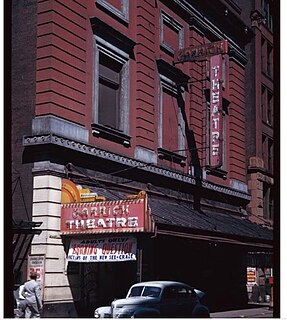
The Garrick Cinema—periodically referred to as the New Andy Warhol Garrick Theatre, Andy Warhol's Garrick Cinema, Garrick Theatre, Nickelodeon—was a 199-seat movie house located in Greenwich Village at 152 Bleecker Street, Lower Manhattan, New York City. Andy Warhol debuted many of his notable films in this building in the late 1960s. Frank Zappa and the Mothers of Invention played here nightly for 6 months in 1967.
John Bailey McElfatrick (1828–1906) was an architect known for his design of theaters in the United States and Canada. He eventually went into practice with his sons William H. McElfatrick and John Morgan McElfatrick (1853-1891) in the firm J. B. McElfatrick & Sons.
